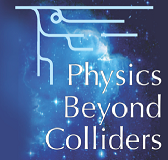Speaker
Description
The high intensity secondary beams at the SPS M2 beam line in combination with the world’s largest polarized nucleon targets as well as large liquid hydrogen and a broad variety of nuclear targets put the COMPASS collaboration in a unique position as a universal experimental facility to study previously unexplored aspects of meson and nucleon structure, QCD dynamics and hadron spectroscopy.
High intensity hadron beams have made COMPASS the world leading facility for hadron spectroscopy and hadron structure study through Drell-Yan production of di-muon pairs. High intensity muon beams in combination with the unique kinematical range covered by the COMPASS experiment enable a very competitive program of studying nucleon structure through semi-inclusive and exclusive hard scattering reactions off polarized targets or liquid hydrogen targets.
Upgrades of the M2 beam line resulting in high intensity RF-separated anti-proton- and kaon-beams would greatly expand the horizon of experimental possibilities at COMPASS: hadron spectroscopy with kaon beam, studies of transverse momentum dependent quark structure for protons, pions and kaons, precise studies of nuclear effects and for the first time measurements of kaon quark-substructure.
